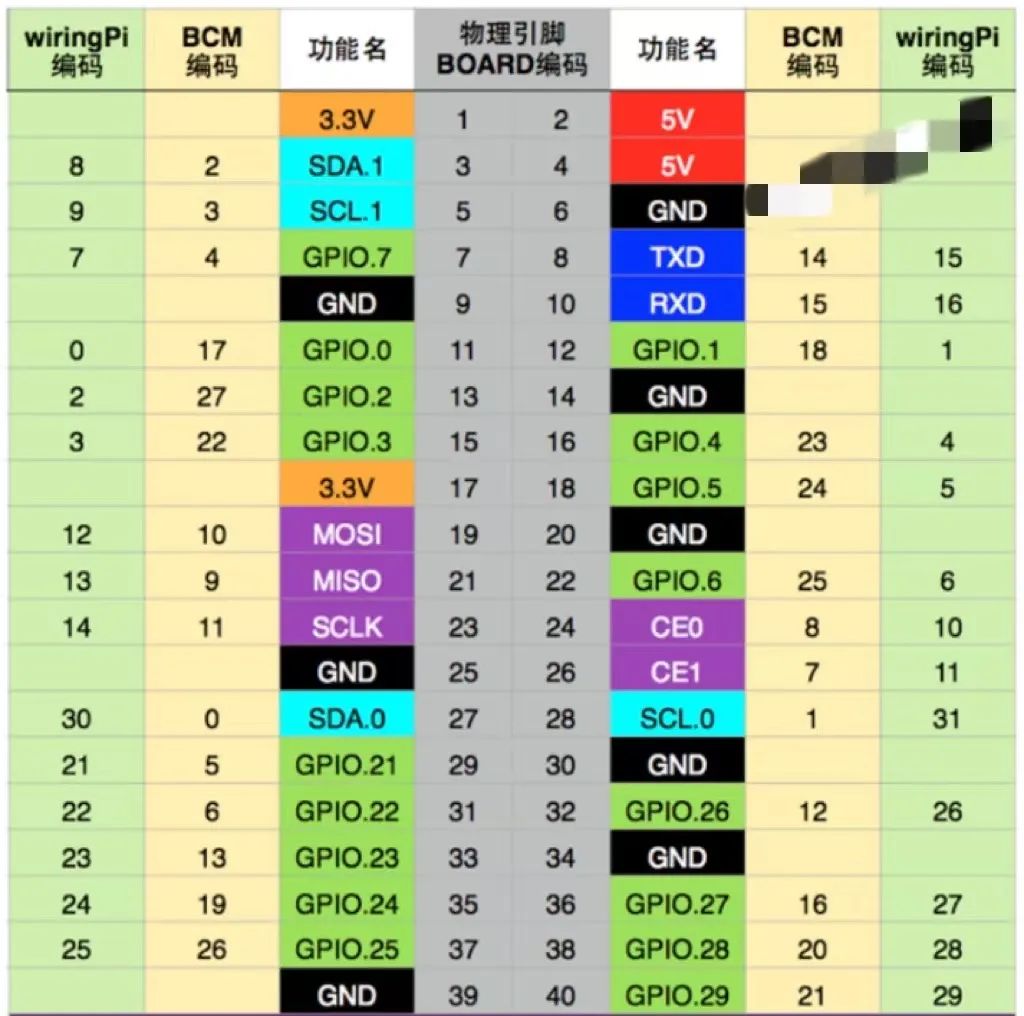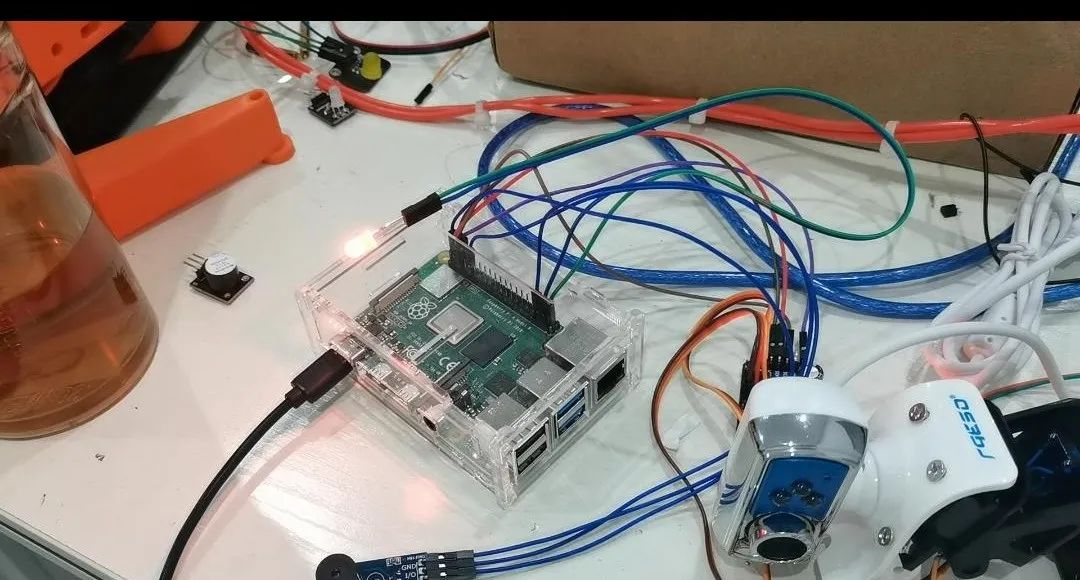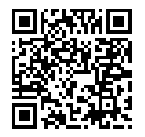0. Introduction
Materials: Raspberry Pi, Camera, Two SG90 Servos, PCA9685 Expansion Board, LED Light, Buzzer Module
1. Introduction to Raspberry Pi Pins
Raspberry Pi Pinout Table

There are three definitions: Wiring Pi encoding, BCM encoding, and BOARD physical pin encoding.
1.1 Pin Setup
First, enter the following command in the terminal:
sudo raspi-configGo to the settings and find
Interfacing OptionsThen find
Remote GPIOEnable GPIO
2. Writing the Code
2.1 Import Libraries
First, import the libraries
import RPi.GPIO as GPIO # 1 Import pin library
GPIO.setmode(GPIO.BOARD) # 2 Define pin mode as BOARD
GPIO.setup(channel, GPIO.OUT) # 3 Create channel, needs two parameters: pin number and mode
GPIO.output(7, True) # 4 Drive channel
GPIO.cleanup() # 5 Clear and release resources2.2 Example Code to Light LED and Sound Buzzer
# Import GPIO module and call pin
import RPi.GPIO as GPIO
# Initialize pin mode as BOARD, suppress warnings
GPIO.setmode(GPIO.BOARD)
GPIO.setwarnings(False)
# Pin definitions: Buzzer on pin 35, LED on pin 37
beep = 35
led = 37
GPIO.setup(beep, GPIO.OUT) # Set GPIO mode as output
GPIO.setup(led, GPIO.OUT)
GPIO.output(led, GPIO.HIGH) # Turn on LED
GPIO.output(led, GPIO.LOW) # Turn off LED
GPIO.output(beep, GPIO.HIGH) # Buzzer sounds
GPIO.output(beep, GPIO.LOW) # Buzzer off
3. Complete Code and Images
#!/usr/bin/env python2
# -*- coding: utf-8 -*-
"""
* @par Copyright (C): 2010-2020, hunan CLB Tech
* @file 50_Hand_gestures.py
* @version V2.0
* @details
* @par History
@author: zhulin
"""
import cv2
import numpy as np
import math
import time
import sys
import Adafruit_PCA9685 # Import PCA9685 module
# Set encoding to utf-8
import importlib
importlib.reload(sys) # sys.setdefaultencoding('utf8')
# Import GPIO module and call pin
import RPi.GPIO as GPIO
# Initialize pin mode as BOARD, suppress warnings
GPIO.setmode(GPIO.BOARD)
GPIO.setwarnings(False)
# Pin definitions: Buzzer on pin 35, LED on pin 37
beep = 35
led = 37
GPIO.setup(beep, GPIO.OUT) # Set GPIO mode as output
GPIO.setup(led, GPIO.OUT)
# Initialize PCA9685 and servo
servo_pwm = Adafruit_PCA9685.PCA9685() # Instantiate servo
# Set initial values for servo, adjust as needed
servo_pwm.set_pwm_freq(60) # Set frequency to 60HZ
servo_pwm.set_pwm(5, 0, 325) # Base servo
servo_pwm.set_pwm(4, 0, 325) # Tilt servo
time.sleep(1)
# Initialize camera and set thresholds
cap = cv2.VideoCapture(0)
cap.set(3, 120)
cap.set(4, 160)
while(1):
try: # Handle errors if no contour found
ret, frame = cap.read()
frame = cv2.flip(frame, 1)
kernel = np.ones((3, 3), np.uint8)
# Define region of interest
roi = frame[0:300, 0:300]
cv2.rectangle(frame, (0, 0), (300, 300), (0, 255, 0), 0)
hsv = cv2.cvtColor(roi, cv2.COLOR_BGR2HSV)
# Define range of skin color in HSV
lower_skin = np.array([0, 20, 70], dtype=np.uint8)
upper_skin = np.array([20, 255, 255], dtype=np.uint8)
# Extract skin color image
mask = cv2.inRange(hsv, lower_skin, upper_skin)
# Extrapolate the hand to fill dark spots within
mask = cv2.dilate(mask, kernel, iterations=4)
# Blur the image
mask = cv2.GaussianBlur(mask, (5, 5), 100)
# Find contours
_, contours, hierarchy = cv2.findContours(mask, cv2.RETR_TREE, cv2.CHAIN_APPROX_SIMPLE)
# Find contour of max area (hand)
cnt = max(contours, key=lambda x: cv2.contourArea(x))
# Approx the contour a little
epsilon = 0.0005 * cv2.arcLength(cnt, True)
approx = cv2.approxPolyDP(cnt, epsilon, True)
# Make convex hull around hand
hull = cv2.convexHull(cnt)
# Define area of hull and area of hand
areahull = cv2.contourArea(hull)
areacnt = cv2.contourArea(cnt)
# Find the percentage of area not covered by hand in convex hull
arearatio = ((areahull - areacnt) / areacnt) * 100
# Find the defects in convex hull with respect to hand
hull = cv2.convexHull(approx, returnPoints=False)
defects = cv2.convexityDefects(approx, hull)
# l = no. of defects
l = 0
# Code for finding no. of defects due to fingers
for i in range(defects.shape[0]):
s, e, f, d = defects[i, 0]
start = tuple(approx[s][0])
end = tuple(approx[e][0])
far = tuple(approx[f][0])
pt = (100, 180)
# Find length of all sides of triangle
a = math.sqrt((end[0] - start[0]) ** 2 + (end[1] - start[1]) ** 2)
b = math.sqrt((far[0] - start[0]) ** 2 + (far[1] - start[1]) ** 2)
c = math.sqrt((end[0] - far[0]) ** 2 + (end[1] - far[1]) ** 2)
s = (a + b + c) / 2
ar = math.sqrt(s * (s - a) * (s - b) * (s - c))
# Distance between point and convex hull
d = (2 * ar) / a
# Apply cosine rule here
angle = math.acos((b ** 2 + c ** 2 - a ** 2) / (2 * b * c)) * 57
# Ignore angles > 90 and ignore points very close to convex hull (they generally come due to noise)
if angle <= 90 and d > 30:
l += 1
cv2.circle(roi, far, 3, [255, 0, 0], -1)
# Draw lines around hand
cv2.line(roi, start, end, [0, 255, 0], 2)
l += 1
# Print corresponding gestures which are in their ranges
font = cv2.FONT_HERSHEY_SIMPLEX
if l == 1:
if areacnt < 2000:
cv2.putText(frame, 'Put hand in the box', (0, 50), font, 2, (0, 0, 255), 3, cv2.LINE_AA)
else:
if arearatio < 12:
cv2.putText(frame, '0', (0, 50), font, 2, (0, 0, 255), 3, cv2.LINE_AA)
elif arearatio < 17.5:
cv2.putText(frame, 'Best of luck', (0, 50), font, 2, (0, 0, 255), 3, cv2.LINE_AA)
else:
cv2.putText(frame, '1', (0, 50), font, 2, (0, 0, 255), 3, cv2.LINE_AA)
GPIO.output(led, GPIO.HIGH) # Turn on LED
elif l == 2:
cv2.putText(frame, '2', (0, 50), font, 2, (0, 0, 255), 3, cv2.LINE_AA)
GPIO.output(led, GPIO.LOW) # Turn off LED
elif l == 3:
if arearatio < 27:
cv2.putText(frame, '3', (0, 50), font, 2, (0, 0, 255), 3, cv2.LINE_AA)
GPIO.output(beep, GPIO.HIGH) # Buzzer sounds
else:
pass # Suppress OK gesture
# cv2.putText(frame, 'ok', (0, 50), font, 2, (0, 0, 255), 3, cv2.LINE_AA)
elif l == 4:
cv2.putText(frame, '4', (0, 50), font, 2, (0, 0, 255), 3, cv2.LINE_AA)
GPIO.output(beep, GPIO.LOW) # Buzzer off
elif l == 5:
cv2.putText(frame, '5', (0, 50), font, 2, (0, 0, 255), 3, cv2.LINE_AA)
GPIO.output(led, GPIO.HIGH) # Turn on LED
time.sleep(0.5)
GPIO.output(beep, GPIO.HIGH) # Buzzer sounds
time.sleep(0.5)
GPIO.output(beep, GPIO.LOW) # Buzzer off
time.sleep(0.5)
GPIO.output(led, GPIO.LOW) # Turn off LED
time.sleep(0.5)
elif l == 6:
cv2.putText(frame, 'reposition', (0, 50), font, 2, (0, 0, 255), 3, cv2.LINE_AA)
else:
cv2.putText(frame, 'reposition', (10, 50), font, 2, (0, 0, 255), 3, cv2.LINE_AA)
# Show the windows
cv2.imshow('mask', mask)
cv2.imshow('frame', frame)
except:
pass
k = cv2.waitKey(5) & 0xFF
if k == 27:
break
cv2.destroyAllWindows()
cap.release()
Functionality:
-
Gesture 1: One finger extended, lights up the LED.
-
Gesture 2: Two fingers extended, turns off the LED.
-
Gesture 3: Three fingers extended, buzzer sounds.
-
Gesture 4: Four fingers extended, buzzer off.
-
Gesture 5: Five fingers extended, sound and light alarm.


“Matlab-Based Simulink Robotic Arm Visualization Tutorial“
This tutorial is based on Matlab R2019B version, starting from basic component introduction to teach how to create a Matlab-based robotic arm visualization simulation system.

(Scan the QR code to view course details)